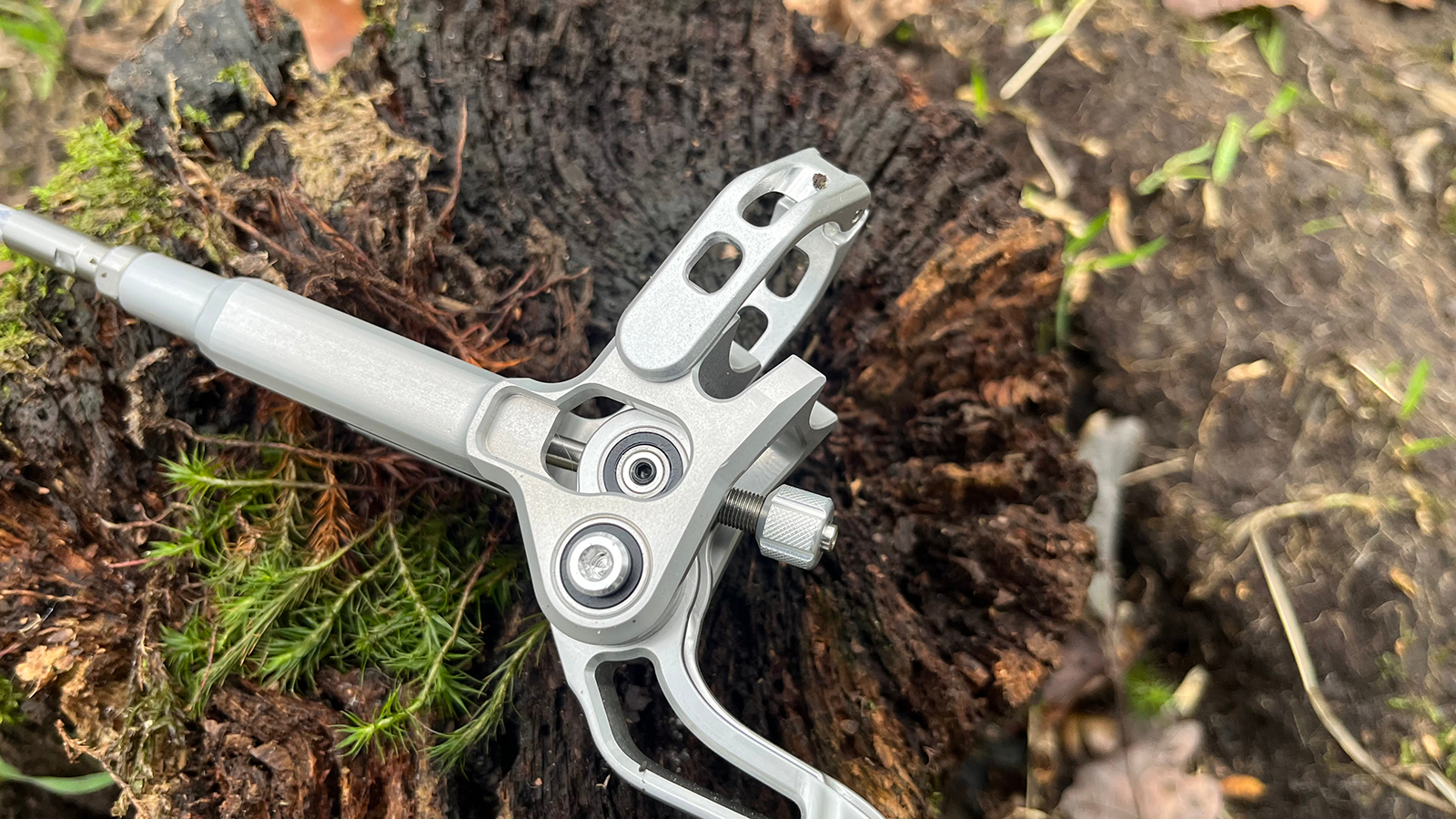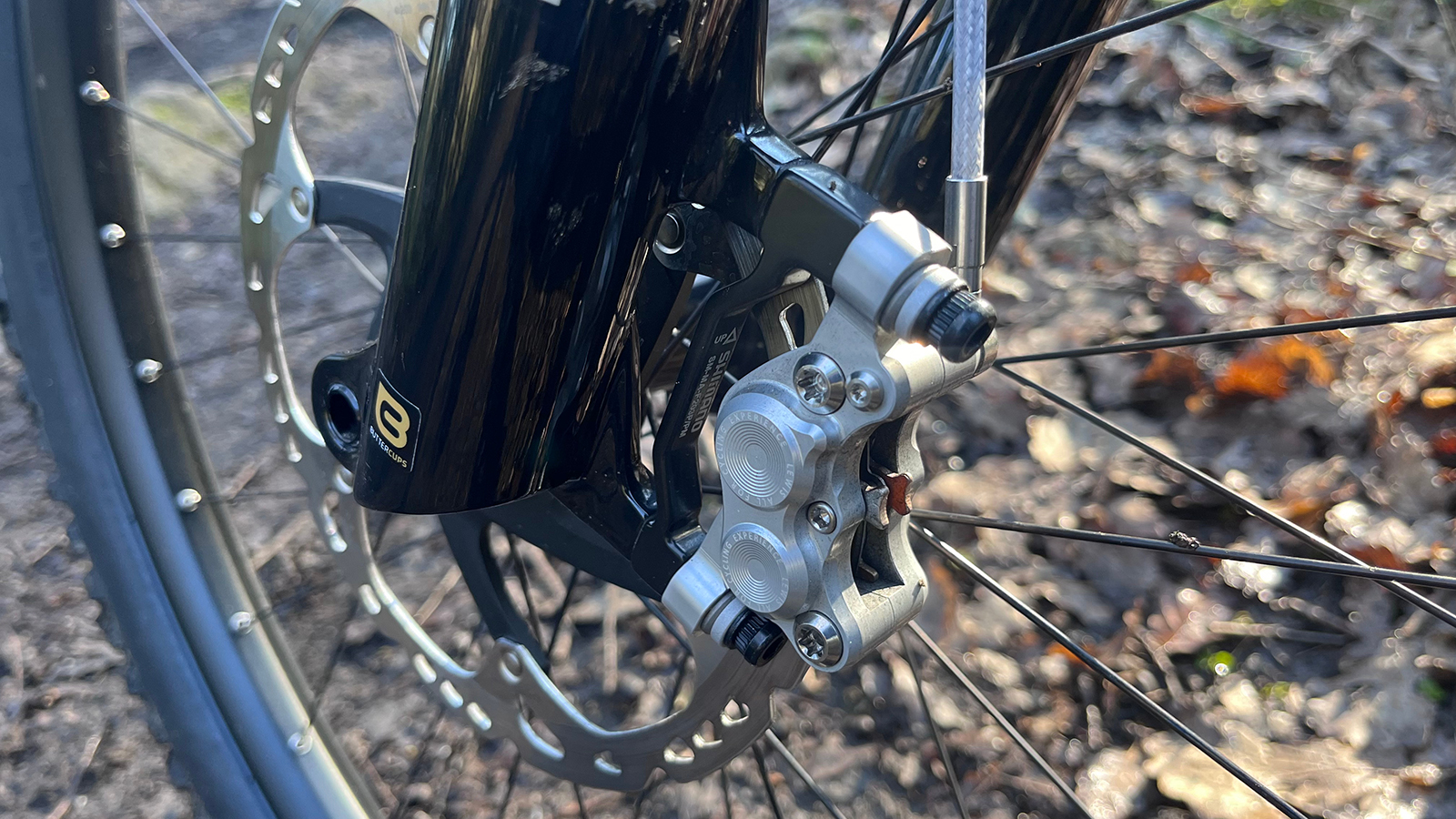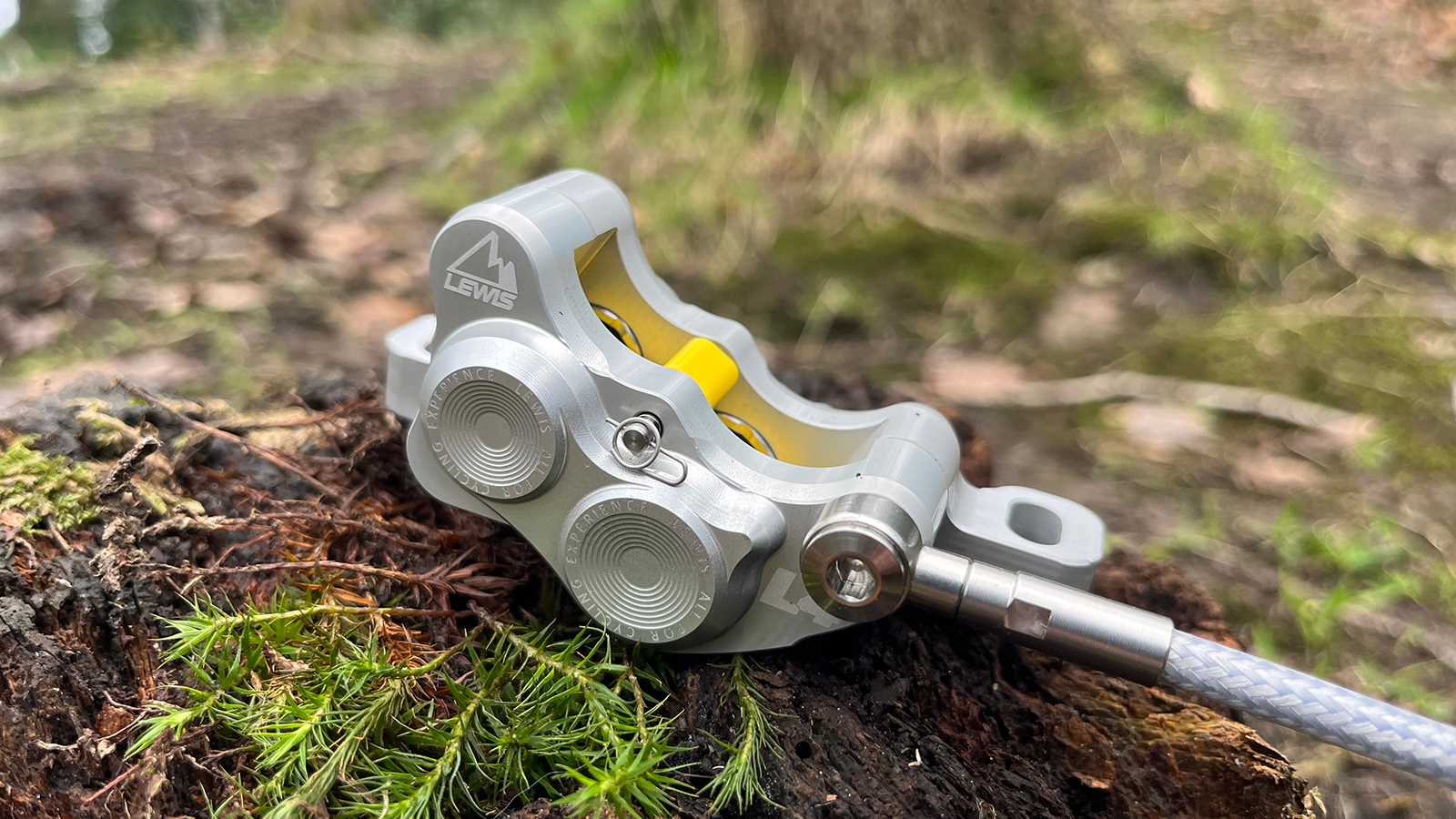
We've previously tested the Lewis LV2 brake and I've been putting some miles in on this heavier-duty LH4 model recently on my local trails, which much like its lighter-weight sibling, strikes an uncanny resemblance to another high-end brake already on the market. The LV2’s mix of power, low weight, and reasonable cost did well, scoring 4.5 out 5 in our review, so how does the LH4 compare to the best mountain bike brakes on the market?

Design and specifications
So, let's talk about the elephant in the room. There's no denying these carry an uncanny resemblance to Trickstuff’s Maxima and Direttissima brakes, which are some of the most expensive and drool-worthy high-end stoppers out there. It is worth noting though, that these are not the same as the blatant copies you see on Temu and similar discount websites. Lewis is the brand name for a legitimate manufacturer based in Ningbo City and has produced high-end brakes for both MTB and moto use for many years now.
The LH4 retails at $339 / £335.99 / €374 for a pair without rotors or adaptors, so they aren't cheap but they do come in considerably lower than the very high priced Trickstuff Maxima at €1,300 and Direttissima at €1,100. They are closer in terms of power and cost to the Hope Tech 4 E4 (at $490 / £390 / €490) and Magura MT7 ($538 / £380 / €438). SRAM’s Code RSC is the closest option spec-wise to the LH4 but comes in at a surprisingly expensive $490 / £460 / €540; though the new Maven is now the top of the enduro and DH SRAM brake tree, I think the Code is a fairer comparison. Shimano offers similar features with more powerful calipers on many brakes, so again, a direct comparison isn't the easiest, though the XT four-pot setup is probably the closest but with a very different aesthetic at $420 / £400 / €400.
It must be said that both the LH4 lever and caliper are CNC-machined to a very high standard, and their weight is a very impressive 238g for the front brake, only 20g more than the XC LV2 setup. The silver finish might be polarizing for some, but I thought it made a welcome change from the usual dark matt-finished cast units from SRAM and Shimano. Other colors are available, such as anodized black and even some crazy multi-color splatter finishes if you want a reminder of the nineties. There is a legacy lifetime warranty mentioned on their website, though details on this are scarce and not very clear.
The brakes came in an understated recyclable box with minimal single-use plastics, which is always good to see. The front and rear brakes arrived set up and pre-bled, with pads, short bolts to mount to an adaptor, and the 2mm bite point adjustment tool, which we will talk about later. Mounts and rotors are available to order, but at the time of shipping, the UK distributor hadn't yet received stock of their latest rotor, which was a shame as it is a thicker than usual 2.3mm stainless steel design and looks good for e-MTB and Alpine usage.

The lever and master cylinder are machined from 7075 T6 aluminum and have a slender profile with a relatively long-looking lever blade, though they are designed to be used with one finger. Lewis states that the LH4 levers have been increased by 6mm, but they don't say what from. I found the shape worked well and had a very solid lever feel with none of the flex you can get from super-light skinny alloy levers or some carbon blades. There are four bearings in each lever, two at the pivot point and two at the linkage between the lever and piston, which keeps things running smoothly. This, combined with very little seal drag in the system, gives an effortless feel in use. Some brakes, particularly ones with overly complex designs, can actually have a lot of resistance in the seals, which can be felt when riding. Although minor, I do think it counts towards fatigue in the hands and arm pump on extended long descents.
The LH4 also features separate reach and bite point adjustments, neatly tucked away on the inside of the lever away from harm, and should survive well if you are unfortunate enough to crash. Lever reach is dealt with by simply turning the silver dial, and although it doesn't click or have any indents, a small amount of turning gives noticeable changes to the reach. The bite point adjustment is built into the same dial, though it uses a centrally mounted 2mm Allen key to adjust. Lewis supplies a neat little tool to do this on the trail, though due to its small size, I did manage to mislay it a couple of times, which is a bit annoying as its angle means using a regular multi-tool hex key is out of the question. A ratchet hex key bit works well as a replacement should you lose the tool. It's not a dealbreaker, as the range of adjustment works well and doesn't suffer any migration issues, but it's something to be aware of.

The lever body is connected to the caliper using a reinforced Kevlar hose, which resembles a metal braided hose. Braided hoses are generally not used on bikes as the extra stiffness reduces the feel or modulation of a brake, but the setup used here works well.
The caliper is a four-pot post-mount affair and features two different-sized, somewhat unusual stainless steel pistons. You often see ceramic or phenolic-coated versions used to prevent the effects of heat build-up from other brands. However, these caused no issues at all in testing and, much like the levers, had very little seal drag and worked incredibly smoothly throughout testing. Lewis uses two different sizes, 14 and 17mm, which is said to improve the linear feel of the brakes as well as balance the pressure distribution of the pad connecting to the rotor.

Performance
The instructions in the box were limited, but most things were pretty straightforward, and they ship already bled. The lever uses a hinged split clamp, which looks neat and is designed to give way in a crash instead of transmitting damage to the rest of your bar, but I found that it was tricky to set up in practice. The tolerances are very tight, so if your bar is slightly oversized, it can be very tricky to line the bolt and thread up, and as the clamp is alloy, it would be very easy to strip the thread if you are not paying attention.
They ship with Lewis’s own rudimentary version of SRAM’s matchmaker shifter mount, but as yet, there's no way to directly mount with a Shimano shifter, which was a pain and required the use of a different shifter with a standard band mount and not an I-Spec version. This also limited the scope for adjustment of the ergonomics between the brake and gears. I got a fit I was happy with, but those who are super fussy about lever setup might be disappointed.
Cutting hoses to length was straightforward once I saw the video on the Lewis website. However, it would have been nice to have something in the box as it's a reusable system that, although good, is different from most brands. Calipers were mounted using my existing Shimano mounts, and I used standard Shimano rotors on 203mm throughout the test period, which caused no issues for me. The pads supplied are a metallic set that gives plenty of bite and stay quiet; they are the same shape as the Hope E4 pads, so there are plenty of aftermarket options out there if you want more bite or longer-lasting versions.

The initial braking feel was very positive and had a short bedding-in process that gave tonnes of bite and power in only a few hard decelerations. They have a very positive metallic feel, accentuated by the very low seal drag, which gives them an impressive, almost effortless action. The front brake was perfect, though the rear, after bedding in, needed a top-up bleed. The bleed process is straightforward and uses the same procedure as Shimano with a syringe at the caliper and a cup or open syringe at the lever. No bleed cup or syringe is supplied, though the thread on the lever end is the same as a RockShox Reverb, so I simply used an open syringe with the correct attachment to do a top-up bleed. I actually had to do this a couple of times after my first few rides, but once settled, it caused me no issues. I suspect there was air caught somewhere in the master cylinder, so bleeding off the bike would be better next time. This is fine for professional mechanics, but it might be a bit too much hassle for amateur wrenchers.
Though the initial bite is very impressive, what is more surprising is the amount of modulation they offer. I have found brakes that have a super-hard bite point are actually difficult to use in technical terrain as they tend to have a very on/off nature, but not so here. After the initial contact of pads on the rotor, there's plenty of feel on offer, allowing you to meter out as much power as you need before locking your wheels.
I was initially a bit skeptical about the use of stainless steel pistons; having worked for several brake brands in the past, they all sang the virtues of non-metallic pistons, but my worries were needless. Despite my best attempts on long, steep descents, I never experienced any issues with fade or warbling noises. In fact, they were eerily quiet on all but the steepest, wettest rides, which I think is partly down to the different-sized pistons causing the pads to connect to the rotor at a light angle, much like how you used to ‘toe-in’ old-school rim brake pads.
The power was on par with similar setups I've used, such as SRAM’s Code series or a multitude of four-piston options from Shimano and Magura. I'd say the initial bite is similar to and possibly better than Shimano but with a more metallic mechanical feel. I like to run my levers close to the bar, which can cause problems if a brake has a lot of lever travel. Still, the bite point adjustment on the LH4 worked really well, making it easy for me to set them up as I liked, and unlike some other designs, there were no wandering adjustments or loss of feeling, no matter how hot I got them.
Reliability is a natural concern with any new brand on the market, but thankfully, that's not been the case here. Once initial bedding in niggles had passed, they worked perfectly throughout an exceptionally wet and grim winter that would show up any flaws. I had thought the low seal drag was a sign of a slightly looser design that may show up as a failure further down the line, but again, no such problems with no leaks, fades, or loss of power or lever feel at any time.

Verdict
It would be all too easy to write Lewis LH4s off as just a piece of fancy machining and anodizing of questionable quality, but in truth, they worked very well, with bags of power and plenty of modulation at a fraction of the cost of brakes that bear many similarities.
There is always the worry of longevity and availability of spare parts down the line, but my dealings with Lewis and their UK distributor put those worries to rest. They offer a good backup service and list spares, though I'm not certain how easy they would be to obtain.
They were straightforward to set up, though some niggles with the clamp and mounting of shifters as well as the fiddly bite point adjustment tool, make them a very good brake but not quite a great one.
Tech specs: Lewis LH4 Brake Set
- Price: $339.00 / £335.99 / €374.00 – set of front and rear brakes, no rotors or mounts
- Sizes: 90cm front hose or 160cm rear
- Options: Silver or black anodized
- Weight: 238g front brake, lever and hose







